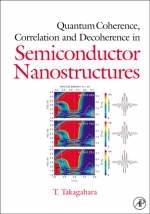
Quantum Coherence Correlation and Decoherence in Semiconductor Nanostructures
Academic Press Inc (Verlag)
978-0-12-682225-0 (ISBN)
Semiconductor nanostructures are attracting a great deal of interest as the most promising device with which to implement quantum information processing and quantum computing. This book surveys the present status of nanofabrication techniques, near field spectroscopy and microscopy to assist the fabricated nanostructures. It will be essential reading for academic and industrial researchers in pure and applied physics, optics, semiconductors and microelectronics.
By Toshihide Takagahara
PrefaceList of ContributorsChapter 1 Coherent Nonlinear Pulse Propagation on a Free-Exciton Resonance in a Semiconductor 1.1 Introduction 1.2 Theoretical Background 1.3 Samples and Experimental Techniques 1.4 Results and Discussion Excitation-Induced Suppression of Temporal Polariton Beating Self-Induced Transmission and Multiple Pulse Breakup Phonon-Induced Dephasing of the Excitonic Polarization 1.5 Conclusions Acknowledgments ReferencesChapter 2 Carrier-Wave Rabi Flopping in Semiconductors 2.1 Introduction 2.2 Carrier-Wave Rabi Flopping Experiments Theory 2.3 Conclusions Acknowledgments ReferencesChapter 3 High-Field Effects in Semiconductor Nanostructures 3.1 Introduction 3.2 General Theory 3.3 High-Field Electo-Optics in Quantum Wells and Wires Real Space Theoretical Approach to Electon–Hole Wave Packets Electro-Magneto-Optical Simulations in Quantum Wells Static Franz–Keldysh Effect in Quantum Wires Dynamic Franz–Keldysh Effect in Quantum Wires 3.4 Excitonic Trapping, Ultrafast Population Transfer, and Rabi Flopping Theory of High Optical Field Effects in Quantum Wells Excitonic Trapping and Ultrafast Population Transfer 3.5 Carrier-Wave Rabi Flopping Theory and Computation of Sub-Optical-Carrier Pulse Propagation Breakdown of the Area Theorem in a Two-Level Atom Carrier-Wave Rabi Flopping in Semiconductors 3.6 Conclusions Acknowledgments ReferencesChapter 4 Theory of Resonant Secondary Emission: Rayleigh Scattering versus Luminescence 4.1 Introduction 4.2 Disorder Eigenstates of Excitons 4.3 Exciton Hamiltonian and Density-Matrix Approach 4.4 Exciton Kinetics with Acoustic Phonon Scattering 4.5 Coherent and Incoherent Emission in the Time Domain 4.6 Speckle Measurement and Interferometry 4.7 Frequency-Resolved Secondary Emission 4.8 Signatures of Level Repulsion 4.9 Enhanced Resonant Backscattering 4.10 Spin- and Polarization-Dependent Emission 4.11 Polariton Effects in the Secondary Emission Appendix A: Potential Variance Appendix B: Weak-Memory and Markov Approximation Appendix C: Radiative Rates ReferencesChapter 5 Higher-Order Coulomb Correlation Effects in Semiconductors 5.1 Introduction 5.2 Ultrafast Spectroscopy of Semiconductor Nanostructures as Probes of Coulomb Correlations Overview of the Semiconductor Equations of Motion with Optical Excitation Non-Interacting and Hartree–Fock Approximations Beyond the Coherent SBE: Screening and Scattering Ultrafast Optical Measurement Techniques 5.3 Beyond the Screened HF Approximation – Theoretical Approaches to Many-Body Correlations Biexcitons and Few-Level Theories The Dynamics-Controlled Truncation Scheme The Coherent Limit Interpreting and Solving the Equations of the DCT The Effective Polarization Model Phonons 5.4 Experimental Studies of High-Order Coulomb Correlations The Fully Coherent Regime Contributions from Incoherent Densities Contributions beyond the Four-Particle Level Contributions beyond the x (3) Truncation 5.5 Future Directions ReferencesChapter 6 Electronic and Nuclear Spin in the Optical Spectra of Semiconductor Quantum Dots 6.1 Introduction to Spin in the Optical Spectrum 6.2 Photoluminescence Spectroscopy of Quantum Dots Natural (Interface Fluctuation) QDs Photoluminescence Spectroscopy of Single QDs PL Excitation Spectroscopy of Single QDs 6.3 Exciton Fine-Structure (Spin and Sublevels) Exchange Interaction Long-Range Exchange Interaction Zeeman Interaction Pseudo-Spin Model Relaxation Polarization Including Finite Relaxation Hanle Effect 6.4 Trions (Singly Charged Excitons) Trions in Natural QDs Fine Structure in Single Trion Spectroscopy Optical Orientation of Negatively Charged Excitons 6.5 Hyperfine Interaction Hyperfine Interaction: Static and Dynamic Dynamical Polarization of Nuclei: Overhauser Effect Nuclear Dipole–Dipole Interactions Optical Nuclear Magnetic Resonance 6.6 Spin Relaxation Spin Relaxation: Spin–Orbit Interactions Spin Relaxation: Hyperfine Interaction Hanle Effect for Localized Electrons 6.7 Conclusions Acknowledgments Appendix Relaxation of the Nuclear Spin Due to the Fluctuating Electronic Spin ReferencesChapter 7 Coherent Optical Spectroscopy and Manipulation of Single Quantum Dots 7.1 Introduction Semiconductor QDs Excitons and Biexcitons Modeling Single QDs Quantum Coherence and Quantum Computing Based on Optically Driven QDs Single QD Optical Spectroscopy 7.2 Single Exciton Optical Spectroscopy PL and PLE Linear Absorption from Single QD Excitons CW and Transient Nonlinear Optical Response from Single QD Excitons Magneto-Excitons 7.3 Coherent Optical Control of Single Exciton States 7.4 Rabi Oscillations of Single Quantum Dots Rabi Oscillation Theory for Two-Level Systems Strong-Field Differential Transmission: Rabi Oscillations of Single QD Excitons Understanding the Decay: Coupling to Delocalized Excitons 7.5 Biexcitons in Single QDs Excitation of Single QD Biexcitons Using CW Fields Dephasing of Biexcitons Direct Measurement of Biexciton Lifetime Biexcitonic Transition Dipole Moment Optical Selection Rules 7.6 Optically Induced Two Exciton-State Entanglement 7.7 Single Quantum Dot as a Prototype Quantum Computer Basic Operations for Quantum Computation The Deutsch–Jozsa Problem Fast Quantum Computing by Pulse Shaping Examples of Pulse Design Fast Control Applied to the Deutsch–Jozsa Algorithm 7.8 Summary ReferencesChapter 8 Cavity QED of Quantum Dots with Dielectric Microspheres 8.1 Introduction 8.2 Whispering Gallery Modes in a Dielectric Microsphere 8.3 Composite System of Dielectric Microsphere and MBE-Grown Nanostructure 8.4 Composite System of Dielectric Microsphere and Semiconductor Nanocrystals Coupling Nanocrystals to a Dielectric Microsphere: Low-Q Regime Coupling Nanocrystals to a Dielectric Microsphere: High-Q Regime Dephasing in Semiconductor Nanocrystals 8.5 Summary Acknowledgments ReferencesChapter 9 Theory of Exciton Coherence and Decoherence in Semiconductor Quantum Dots 9.1 Introduction 9.2 Exciton Rabi Splitting in a Single Quantum Dot 9.3 Dressed Exciton State 9.4 Exciton Rabi Oscillation in a Single Quantum Dot 9.5 Bloch Vector Model 9.6 Numerical Results and Discussion 9.7 Wave Packet Interferometry 9.8 Effect of Two-Photon Coherence 9.9 Exciton Dephasing in Semiconductor Quantum Dots 9.10 Green Function Formalism of Exciton Dephasing Rate 9.11 Exciton–Phonon Interactions 9.12 Excitons in Anisotropic Quantum Disk 9.13 Temperature-Dependence of the Exciton Dephasing Rate 9.14 Elementary Processes of Exciton Pure Dephasing 9.15 Mechanisms of Population Decay of Excitons Phonon-Assisted Population Relaxation Phonon-Assisted Exciton Migration 9.16 Recent Progress in Studies on Exciton Decoherence 9.17 Theory of Dephasing of Nonradiative Coherence 9.18 Summary Acknowledgments ReferencesIndex
| Erscheint lt. Verlag | 10.2.2003 |
|---|---|
| Verlagsort | San Diego |
| Sprache | englisch |
| Maße | 152 x 229 mm |
| Gewicht | 960 g |
| Themenwelt | Technik |
| ISBN-10 | 0-12-682225-5 / 0126822255 |
| ISBN-13 | 978-0-12-682225-0 / 9780126822250 |
| Zustand | Neuware |
| Haben Sie eine Frage zum Produkt? |
aus dem Bereich


